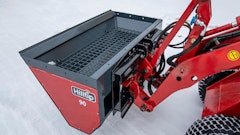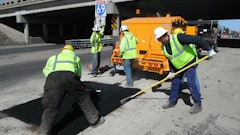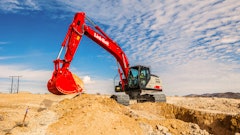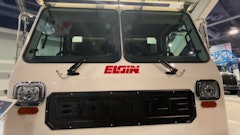
There are several types of machines and vehicles that can perform snow and ice removal tasks, but few offer the advantages of compact equipment. Skid-steer loaders, utility work machines and utility vehicles (UTVs) with versatile attachments can manage the elements more efficiently in open public areas as well as constricted spaces.
Properly maintaining sidewalks and parking lots in the winter is an essential service. Keeping these high-traffic areas clean can be challenging as space becomes confined with snow piles, impatient motorists and distracted pedestrians on slick surfaces. That’s why it’s so critical to select the right tools for the conditions.
Compact equipment and its attachments also allow crews to prioritize high-risk areas like “sidewalk gutters,” the area between the sidewalk and the parking lot, where pedestrians step from one surface and height to another. Keeping these gutters, as well as drainage areas/grates, clear of snow and ice can prevent the hazards associated with melting, pooling and refreezing.
Working in buildings and grounds applications like hospitals, corporate or educational campuses, parks and recreational facilities requires a level of agility not typical of pickup trucks with blades or larger snow removal equipment. “You need maneuverability to clear snow in full parking lots. Additionally, you have to clear sidewalks where you may be working around tight spots and obstructions like fountains and benches or other types of permanent fixtures on the grounds,” says Bobcat Company Marketing Manager Chris Knipfer.
Loaders and utility vehicles
Designed to turn within their own length, skid-steer loaders’ maneuverability, nimbleness and traction make them very popular for removing snow in even the tightest quarters, such as crowded parking lots. And unlike a pickup truck with a snow blade, a skid-steer loader can lift and load snow for transport.
Two-wheel and four-wheel drive utility vehicles can also provide compact solutions for quickly removing light to moderate snow on sidewalks and pathways. Another type of compact equipment that can enhance a building and grounds snow removal fleet includes larger utility work machines. This unique class combines the most practical features of a utility vehicle, pickup truck, compact tractor and skid-steer loader into one machine.
A utility work machine’s four-wheel drive and weight distribution provide the traction and pushing power needed for fast and efficient snow removal. Because it has all-wheel steering and a tighter turning radius than most pickup trucks, the utility work machine is often used for plowing in confined areas that require machine maneuverability to stay efficient. This typically includes the areas between parked cars or around permanent structures like signs, light posts, mailboxes and landscaping beds.
Versatile tool carriers
Engineered to complete a wider variety of snow and ice removal projects faster and easier, compact machines make extremely versatile tool carriers. Loader and utility vehicle attachments commonly used to complete winter tasks may include a snow blade, push broom, snowblower, scraper, snow pusher and a variety of buckets.
New hydrostatic drive utility vehicles are expanding the industry’s definition of UTV attachment capabilities. These versatile units now offer the capacity to operate front-mounted snow attachments, such as snowblowers and angle brooms, which are PTO driven.
This PTO capability on a UTV represents significant maintenance and performance advantages for operators. For example, non-PTO snowblowers and angle brooms on a UTV would require a separate gas engine that would drive up the attachment’s initial cost as well as its maintenance. Operators would also not achieve the level of performance possible from powering the attachment with a larger UTV engine. Additionally, operators typically can’t vary the speed of the non-PTO attachment engine to enhance performance.
For lighter snowfalls, an angle broom attachment is ideal for sweeping less than six inches of snow. In addition to clearing snow from parking lots, sidewalks and pathways in the winter, this attachment can be used for sweeping away dirt, leaves, gravel and other debris, which makes it valuable all year-round.
Depending upon your pavement’s configuration, you may also consider the versatility and convenience afforded with a snow V-blade, which some manufacturers have built for multi-directional use as a straight blade, V-cut blade, scoop blade and a left- or right-angle blade.
For example, Knipfer says, if an abundance of room is available along a sidewalk, the snow blade or angle broom attachments can assist loaders and utility vehicles to quickly push snow off of pavement. “When snow needs to be pushed quickly, but you also have to stack it, a bucket or a snow pusher can also be used to pile snow,” Knipfer says.
Additionally, he points out that extremely deep snow or high existing snow banks may prohibit the use of broom or blade attachments. “If you don’t have the room to furrow snow off to the side, you can attach a snowblower and shoot it up on top or over the top of the bank,” Knipfer adds. While the snowblower attachment proves ideal for blowing snow away from the area, it can also direct it into a dump truck if equipped with a truck-loading chute.
Taking snow and ice removal one step further, a spreader attachment can be mounted in a utility work machine’s cargo box. It can be used to spread salt and sand on sidewalks and pathways, making it ideal for more snow removal tasks for buildings and grounds applications.
Compact visibility
One of the biggest factors that will impact operator productivity in any snow removal project is visibility. Keeping buildings and grounds clean usually means operating skid-steer loaders, utility vehicles and utility work machines around obstacles that range from people and structures to vegetation and vehicles.
“In snow removal operations you’re often working in reverse just as much as going forward. It’s important to have visibility behind your machine,” Knipfer says.
Likewise, a cab-forward design on skid-steer loaders positions the operator closer to the attachment, providing superior visibility to the working area of the attachment, such as the cutting edge and bucket corners. Larger rear and side windows and good sightlines to tires improves overall visibility, while powerful lighting plays a key role in removing snow in the dark.
“For the person that’s in a machine for 12 hours and is constantly looking out, good visibility is a huge factor,” Knipfer adds.
Article provided by Bobcat Company


























